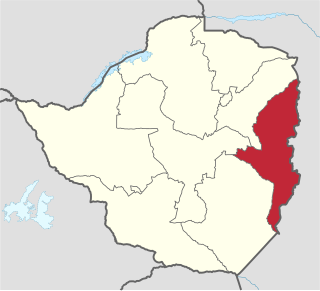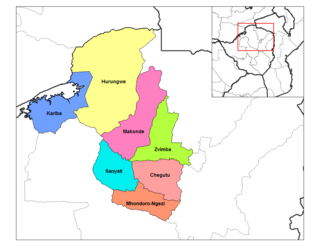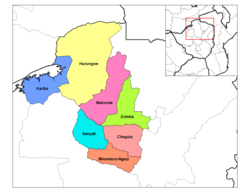
Manicaland is a province in eastern Zimbabwe. After Harare Province, it is the country's second-most populous province, with a population of 2.037 million, as of the 2022 census. After Harare and Bulawayo provinces, Manicaland is Zimbabwe's third-most densely populated province. Manicaland was one of five original provinces established in Southern Rhodesia in the early colonial period. The province endowed with country's major tourist attractions, the likes of Mutarazi Falls, Nyanga National Park and Zimbabwe's top three highest peaks. The province is divided into ten administrative subdivisions of seven rural districts and three towns/councils, including the provincial capital, Mutare. The name Manicaland is derived from one of the province's largest ethnic groups, the Manyika, who originate from the area north of the Manicaland province and as well as western Mozambique, who speak a distinct language called ChiManyika in Shona.

Mashonaland West is a province of Zimbabwe. It has an area of 57,441 km² and a population of approximately 1.9 million (2022). Chinhoyi is the capital of the province.

The Chinhoyi Caves are a group of limestone and dolomite caves in north central Zimbabwe. Designated a National Park in 1955, and managed by the Zimbabwe Parks & Wildlife Management Authority.
Chegutu, originally known as Hartley, is a town in Mashonaland West Province, Zimbabwe.
Alaska is a small town in central northern Zimbabwe in Makonde District, Mashonaland West Province.
Banket is a town in the province of Mashonaland West, Zimbabwe. It is located about 95 km north-west of Harare on the main Harare-Chinhoyi road. According to the 1982 Population Census, the town had a population of 5,698. The name of the town is derived from banket rock formation: early settlers saw a conglomerate, which they hoped would bear gold, like the banket of the Witwatersrand gold fields. The conglomerate was not gold-bearing, although gold was late discovered and, along with chromite, is still mined in the area. Cattle, maize, cotton and tobacco are commercially farmed in the area.
Raffingora is a small town in the province of Mashonaland West, Zimbabwe. It is located about 45 km north-east of Chinhoyi in one of Zimbabwe's leading tobacco growing districts. The town was heavy with agricultural activities before the land reform program. A lot of farms are not producing due to poor agricultural and political practices. The town further suffered from the expropriation of white-owned commercial farms in the controversial land reform programme that began in 2000. The town's main source of income and business clientele, the farmers and businesspeople, all but disappeared from the scene, leading to a loss of business and income. The settlers who took over the farms failed to fill the gap created by the demise of commercial farms. This led to the collapse of retail businesses and the few industries that were in the town.
Lion's Den is a small town in Zimbabwe.
Karoi is a town in Zimbabwe.
Chinhoyi, previously known as Sinoia during the colonial era, is a city in central northern Zimbabwe in the Makonde District. It has a population of 90,800 and is primarily a college town, although it was originally founded as an Italian group settlement scheme. The nearby Chinhoyi Caves and national park are a popular attraction.

Mwami is a settlement in the province of Mashonaland West, Zimbabwe.

The following outline is provided as an overview of and topical guide to Zimbabwe:
Murombedzi is a town in Zimbabwe.
Sabina Gabriel Mugabe was a Zimbabwean politician. She was the younger sister of the former Zimbabwean president Robert Mugabe.

Chegutu, originally known as Hartley, is a district of Mashonaland West Province, Zimbabwe. The district headquarters is located in Chegutu, a city which lies of the Harare-Bulawayo Road,.

Makonde District is a district in Zimbabwe.
Moleli High School, is a co-education high school located in Mashonaland West Province, Makwiro, Chegutu District, Msengezi area near the town of Norton in the Zvimba area, 80 kilometres southwest of the Zimbabwean capital Harare. It offers O' and A' levels in boarding facilities. It was established in 1962 by Ronald E. Sellers of the Methodist Church in Zimbabwe and named after the late Methodist Rev. Modumedi Moleli and is a Methodist mission school. Moleli has a student population of about 620 pupils, and is considered one of Zimbabwe's top performing high schools. It is a sister school to Sandringham High School which they share sibling rivalry.
The A5 Highway is a national road in Zimbabwe. It joins the cities of Harare and Bulawayo, and is hence known as the Harare-Bulawayo Highway. It is one of the two routes that form the R2 Route, which connects Harare with the Plumtree Border with Botswana.
Glen View is a high-density suburb that lies on the border of Harare Province and Mashonaland West. It split between the two provinces, with the larger part on Harare’s side and the remainder on Mashonaland West side under their governance of Zvimba Rural District. It is believed to have 160,000(6.4% of Harare’s population) people although the Zimstat says it has on 45,000 people. It shares boundaries with Budiriro on the North (4.341km), Glen Norah on the East(4.0km), South and West being Mashonaland West. It is divided into 8 parts namely Glen View 1, 2, 3, 4, 7, 8, 1 Extension and Riverside. It has around 15000 residential stands which ranges from 200sqm to 500sqm with most of them averaging 10 people per house.






